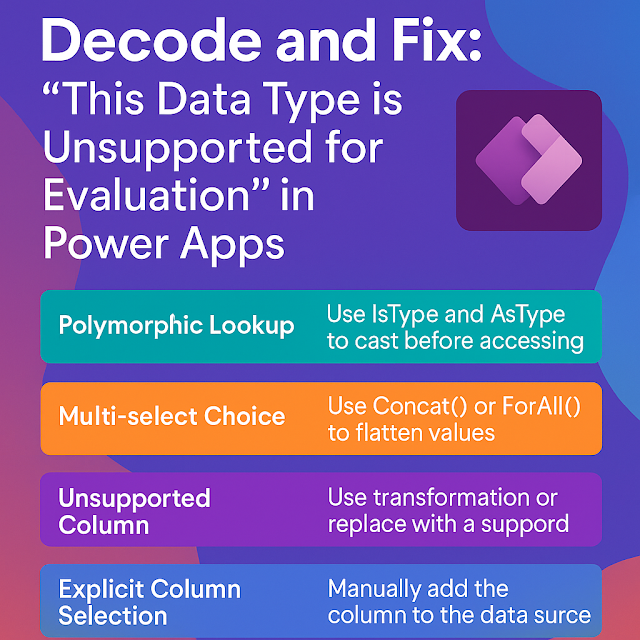A Developer’s Guide to Key Columns in Dataverse (Entities Reimagined)
Key Columns in Dataverse (Entities Reimagined) play a vital role in ensuring data integrity, uniqueness, and efficient record management within the Microsoft Power Platform. In Dataverse, every table (previously known as an entity) includes a Primary Key that uniquely identifies each record, typically represented by a GUID, and a Primary Name Column, which provides a human-readable name for display in views and lookups. Developers can also define Alternate Keys, which allow external systems to identify and update records using natural business data—such as an email address, employee ID, or product code—rather than system-generated IDs. This feature is especially useful for integrations, upsert operations, and data migrations, as it simplifies record matching and reduces duplication. By leveraging these key columns effectively, Dataverse ensures consistency across related data, enhances performance, and provides developers with a flexible foundation for building scalable and reliable business applications.
“Entities Reimagined” means that Dataverse tables are the next evolution of entities, redefined for today’s low-code and AI-driven app development world—more open, more flexible, and more aligned with standard data modeling concepts.
In Microsoft Dataverse, key columns are special fields used to uniquely identify each record in a table (formerly called an entity). While they serve a similar purpose to primary keys in traditional databases, they are more flexible, powerful, and integrated within the Dataverse environment.
1. Primary Key (Default Key Column)
- Every table in Dataverse automatically includes a primary key column, which uniquely identifies each record.
- This column typically follows the format:
- <tablename>id (e.g., accountid, contactid, incidentid).
- It’s a GUID (Globally Unique Identifier)—ensuring uniqueness across not just one table or database, but across environments and integrations.
- You cannot modify or remove the primary key column.
How it differs from traditional databases:
- Traditional databases often use integer-based keys (like auto-increment IDs), which are unique only within one database.
- Dataverse uses GUIDs, making it ideal for distributed systems, cloud replication, and integration with Power Platform, Dynamics 365, and Azure services.
2. Alternate Keys
- Dataverse allows you to define additional keys (alternate keys) to uniquely identify records based on one or more other columns.
- Example: You could define an alternate key on Email Address for Contacts or Account Number for Accounts.
Benefits:
- Useful when integrating with external systems that use natural keys (like CustomerID or SKU).
- Improves data import performance by letting Dataverse locate records based on alternate keys instead of record IDs.
- Ensures data consistency without relying only on GUIDs.
Difference from traditional databases:
- In SQL, you might define a composite key or unique constraint.
- In Dataverse, alternate keys are managed and enforced at the application layer through the platform’s metadata, not through direct SQL constraints.
3. Logical and Physical Differences
- The primary key in Dataverse is system-managed and cannot be manually updated.
- Alternate keys are user-defined and can be changed or removed.
- Dataverse stores keys in a way that supports low-code development, data synchronization, and API-based integrations, whereas traditional databases rely purely on schema definitions.
- The Primary Key (accountid, contactid, etc.) is the main identifier used in plugin logic.
- It’s always available in the plugin’s context (Target.Id) and is used to retrieve, update, or delete records.
- Used in almost every plugin for lookups, relationships, and updates.
- Critical for cascading operations and validations.
- Used for logging, tracing, or displaying readable names in plugin logs.
- Not used for data relationships (since it’s not unique).
- Helpful for debugging or audit logs.
- Provides human-readable info in plugin traces or notifications.
- Used to locate or reference records without needing their GUID.
- Especially useful for integration-friendly plugins.
- Simplifies upsert (update or create) operations.
- Makes plugins resilient to data migrations or system GUID changes.
- Used behind the scenes by Dataverse connectors.
- When selecting a record from a dynamic dropdown, Power Automate actually uses the record’s GUID.
- Used internally for all CRUD operations.
- This is what you see in Power Automate dropdowns.
- It provides user-friendly display names, not unique values.
- Display in dropdowns and dynamic content for readability.
- Used in “Update or Add a row” (Upsert) actions.
- Lets you reference or create records using a business key instead of GUID.
- Simplifies data integration flows between systems (e.g., from ERP or SAP to Dataverse).
- Enables idempotent (non-duplicate) data imports.
- The standard way to retrieve, update, or delete records via Web API.
- Appears in the response payload and can be used for display, but not for identification.
Example (response):{"accountid": "3F7A1C9B-22E3-4D0B-A132-51C3C91A73D7","name": "Contoso Ltd.","accountnumber": "ACCT-001"}
- Used for UI representation and logging.
- Used in OData URLs to identify records by business values.
- Cleaner, readable URLs.
- Easier integration with external systems that don’t know the GUID.
- Often used when Dataverse is the master system.
- The external system stores the GUID to keep a direct reference.
- One-way integrations from Dataverse → external systems.
- Used in reports, dashboards, or messages for readability.
- Used when external systems (ERP, HR, etc.) already have unique identifiers.
- Allows mapping between systems using natural business keys.
- Enables seamless data synchronization and prevents duplication.
- Simplifies integration mappings (no need to store GUIDs externally).















Comments
Post a Comment